wheel FIAT DUCATO BASE CAMPER 2015 Owner handbook (in English)
[x] Cancel search | Manufacturer: FIAT, Model Year: 2015, Model line: DUCATO BASE CAMPER, Model: FIAT DUCATO BASE CAMPER 2015Pages: 367, PDF Size: 19.73 MB
Page 54 of 367
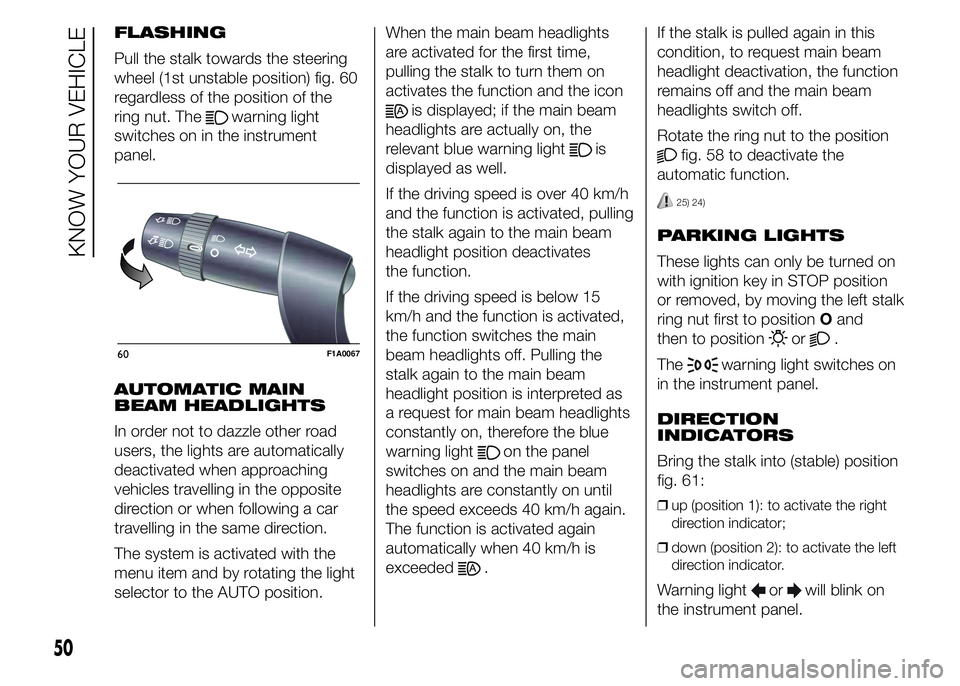
FLASHING
Pull the stalk towards the steering
wheel (1st unstable position) fig. 60
regardless of the position of the
ring nut. The
warning light
switches on in the instrument
panel.
AUTOMATIC MAIN
BEAM HEADLIGHTS
In order not to dazzle other road
users, the lights are automatically
deactivated when approaching
vehicles travelling in the opposite
direction or when following a car
travelling in the same direction.
The system is activated with the
menu item and by rotating the light
selector to the AUTO position.When the main beam headlights
are activated for the first time,
pulling the stalk to turn them on
activates the function and the iconis displayed; if the main beam
headlights are actually on, the
relevant blue warning light
is
displayed as well.
If the driving speed is over 40 km/h
and the function is activated, pulling
the stalk again to the main beam
headlight position deactivates
the function.
If the driving speed is below 15
km/h and the function is activated,
the function switches the main
beam headlights off. Pulling the
stalk again to the main beam
headlight position is interpreted as
a request for main beam headlights
constantly on, therefore the blue
warning light
on the panel
switches on and the main beam
headlights are constantly on until
the speed exceeds 40 km/h again.
The function is activated again
automatically when 40 km/h is
exceeded
.If the stalk is pulled again in this
condition, to request main beam
headlight deactivation, the function
remains off and the main beam
headlights switch off.
Rotate the ring nut to the position
fig. 58 to deactivate the
automatic function.
25) 24)
PARKING LIGHTS
These lights can only be turned on
with ignition key in STOP position
or removed, by moving the left stalk
ring nut first to positionOand
then to position
or.
The
warning light switches on
in the instrument panel.
DIRECTION
INDICATORS
Bring the stalk into (stable) position
fig. 61:
❒up (position 1): to activate the right
direction indicator;
❒down (position 2): to activate the left
direction indicator.
Warning lightorwill blink on
the instrument panel.
60F1A0067
50
KNOW YOUR VEHICLE
Page 55 of 367
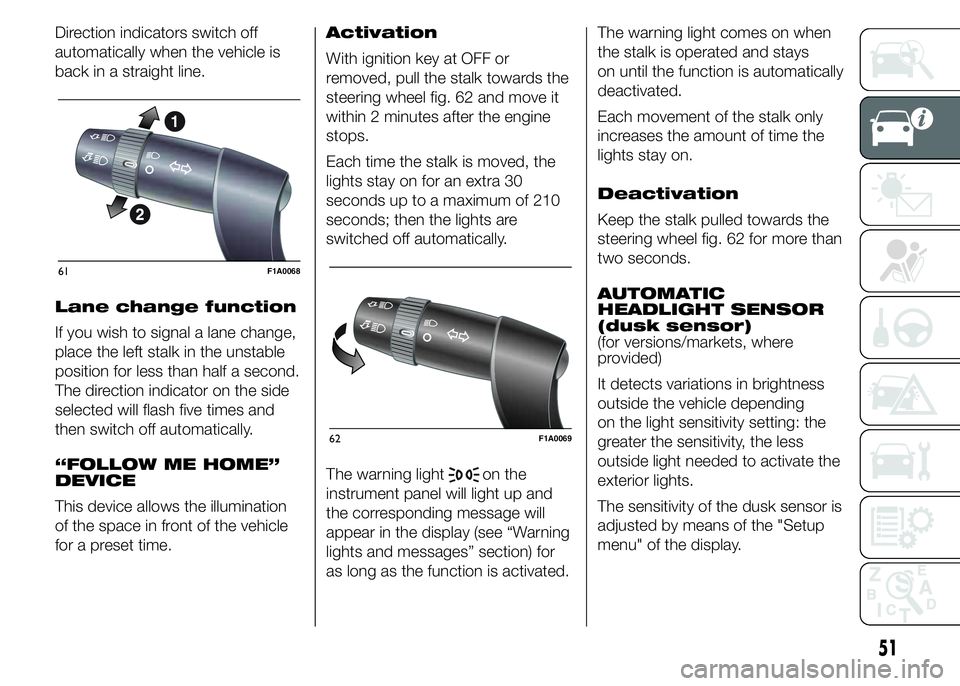
Direction indicators switch off
automatically when the vehicle is
back in a straight line.
Lane change function
If you wish to signal a lane change,
place the left stalk in the unstable
position for less than half a second.
The direction indicator on the side
selected will flash five times and
then switch off automatically.
“FOLLOW ME HOME”
DEVICE
This device allows the illumination
of the space in front of the vehicle
for a preset time.Activation
With ignition key at OFF or
removed, pull the stalk towards the
steering wheel fig. 62 and move it
within 2 minutes after the engine
stops.
Each time the stalk is moved, the
lights stay on for an extra 30
seconds up to a maximum of 210
seconds; then the lights are
switched off automatically.
The warning light
on the
instrument panel will light up and
the corresponding message will
appear in the display (see “Warning
lights and messages” section) for
as long as the function is activated.The warning light comes on when
the stalk is operated and stays
on until the function is automatically
deactivated.
Each movement of the stalk only
increases the amount of time the
lights stay on.
Deactivation
Keep the stalk pulled towards the
steering wheel fig. 62 for more than
two seconds.
AUTOMATIC
HEADLIGHT SENSOR
(dusk sensor)
(for versions/markets, where
provided)
It detects variations in brightness
outside the vehicle depending
on the light sensitivity setting: the
greater the sensitivity, the less
outside light needed to activate the
exterior lights.
The sensitivity of the dusk sensor is
adjusted by means of the "Setup
menu" of the display.
61F1A0068
62F1A0069
51
Page 57 of 367
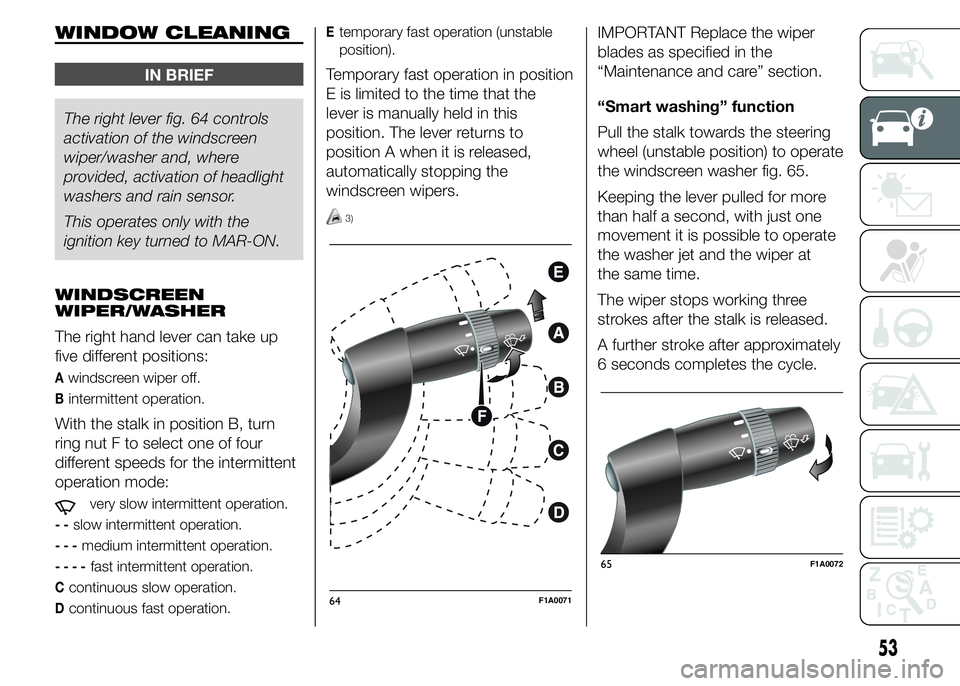
WINDOW CLEANING
IN BRIEF
The right lever fig. 64 controls
activation of the windscreen
wiper/washer and, where
provided, activation of headlight
washers and rain sensor.
This operates only with the
ignition key turned to MAR-ON.
WINDSCREEN
WIPER/WASHER
The right hand lever can take up
five different positions:
Awindscreen wiper off.
Bintermittent operation.
With the stalk in position B, turn
ring nut F to select one of four
different speeds for the intermittent
operation mode:
very slow intermittent operation.
--slow intermittent operation.
---medium intermittent operation.
----fast intermittent operation.
Ccontinuous slow operation.
Dcontinuous fast operation.
Etemporary fast operation (unstable
position).
Temporary fast operation in position
E is limited to the time that the
lever is manually held in this
position. The lever returns to
position A when it is released,
automatically stopping the
windscreen wipers.
3)
IMPORTANT Replace the wiper
blades as specified in the
“Maintenance and care” section.
“Smart washing” function
Pull the stalk towards the steering
wheel (unstable position) to operate
the windscreen washer fig. 65.
Keeping the lever pulled for more
than half a second, with just one
movement it is possible to operate
the washer jet and the wiper at
the same time.
The wiper stops working three
strokes after the stalk is released.
A further stroke after approximately
6 seconds completes the cycle.
64F1A0071
65F1A0072
53
Page 74 of 367

The tachograph is installed and
sealed by authorised personnel: do
not try and access the device or
the supply and recording leads
in any way. It is the responsibility of
the owner of the vehicle on which
the tachograph is installed to check
the device regularly.
The check must be carried out at
least every two years and a test
must be carried out to ensure that it
is working properly. Ensure that
the data label is renewed after
every check and that the
label contains the specified data.SPEED BLOCK
(for versions/markets, where
provided)
The vehicle is equipped with a
speed limitation function that can
be set at the user's request to one
of 4 predefined values: 90, 100,
110, 130 km/h.
To activate/deactivate this function,
contact a Fiat Dealership.
Following the operation, a sticker
will be applied to the windscreen
showing the maximum speed
setting.
IMPORTANT The speedometer
could indicate a higher maximum
speed than the effective one, set by
the Dealership, in accordance with
the regulations in force.
SELF-LEVELLING AIR
SUSPENSION
GENERAL
INFORMATION
The system only acts on the rear
wheels.
The system maintains the rear ride
setting for the vehicle constant in
any loading condition, while
ensuring a greater driving comfort.
In addition, the system allows
the height of the vehicle to
be adjusted with the vehicle
stationary, by selecting from 7
different positions to facilitate
access to the rear compartment.
HEIGHT ADJUSTMENT
There are 7 pre-defined levels for
the free height from the ground:
from “ride -3” to “ride 0” till “ride
+3”.
The multifunction display, located in
the middle of the instrument panel,
can show the ride position.
70
KNOW YOUR VEHICLE
Page 84 of 367

WARNING
45) For safety reasons, the bonnet
must always be perfectly closed
while travelling. Make sure that
the bonnet is perfectly closed and
that the lock is engaged. If you
notice when driving that the
bonnet has not been properly
locked, stop immediately
and close the bonnet correctly.
46) Incorrect positioning of the stay
rod may cause the bonnet to drop
suddenly.
47) Perform these operations only
when the vehicle is stationary.
ROOF RACK/SKI
RACK
To fit the roof/ski rack, with
provision for versions H1 and H2,
use the pins A provided on the
edges of the roof fig. 123.
Long wheelbase vehicles are
equipped with 8 pins; short or
medium wheelbase vehicles are
equipped with 6 pins; vehicles with
extra-long wheelbases are
equipped with 10 pins.
48) 49)
6) 7)
IMPORTANT Follow the instructions
contained in the assembly kit
carefully. Assembly must be
performed by qualified personnel.
WARNING
48) After travelling for a few
kilometres, check to ensure that
the fixing screws for the
attachments are well tightened.
49) Evenly distribute the load and
take into account, when driving,
the increased responsiveness
of the vehicle to side wind.
IMPORTANT
6) The size of the loads you
transport must strictly comply
with currently applicable
regulations.
7) Never exceed the maximum
permitted loads (see “Technical
specifications” section).
123F1A0130
80
KNOW YOUR VEHICLE
Page 86 of 367

ABS
This is an integral part of the
braking system, which prevents
one or more wheels from locking or
slipping regardless of the road
surface conditions and braking
intensity, ensuring control of the
vehicle even during emergency
braking.
The system intervenes when
braking and the wheels are about
to lock, typically in emergency
braking or low-grip conditions,
when locking may be more
frequent.
The ABS ensures the direction of
the vehicle while braking and
optimises the braking distances at
the same time.
The system also improves control
and stability of the car when
braking on a surface where the grip
of the left and right wheels varies,
or when braking on corners.
The system is completed by EBD
(Electronic Braking Force
Distribution), which distributes the
braking action between the front
and rear wheels.IMPORTANT To obtain the
maximum efficiency of the braking
system, a bedding-in period of
about 500 km is needed: during
this period it is better to avoid
sharp, repeated and prolonged
braking.
50)
SYSTEM
INTERVENTION
The driver can feel that the ABS
has come into action because the
brake pedal pulsates slightly and
the system gets noisier: it means
that the car speed should be
altered to suit the type of road
surface.
51) 52) 52) 53) 54) 55) 56) 57)
MSR SYSTEM
(Motor Schleppmoment
Regelung)
This system is an integral part of
the ABS and intervenes, if there is
sudden downshifting, restoring
torque to the engine, thereby
preventing excessive drive at the
drive wheels which, especially
in poor grip conditions, could lead
to a loss in stability of the vehicle.
WARNING
50) The ABS exploits the grip
available to the full, but it cannot
improve it. Therefore, you should
take great care when driving on
slippery surfaces, without taking
unnecessary risks.
51) When the ABS intervenes and
you notice the brake pedal
pulsating, keep the pedal pushed
down and don’t be alarmed. This
will help you to stop in the
shortest distance possible,
depending on the road conditions.
52) If the ABS intervenes, it means
you have almost reached the grip
limit between the tyres and the
road surface: slow down to make
sure that you drive in accordance
with the available grip
82
KNOW YOUR VEHICLE
Page 87 of 367
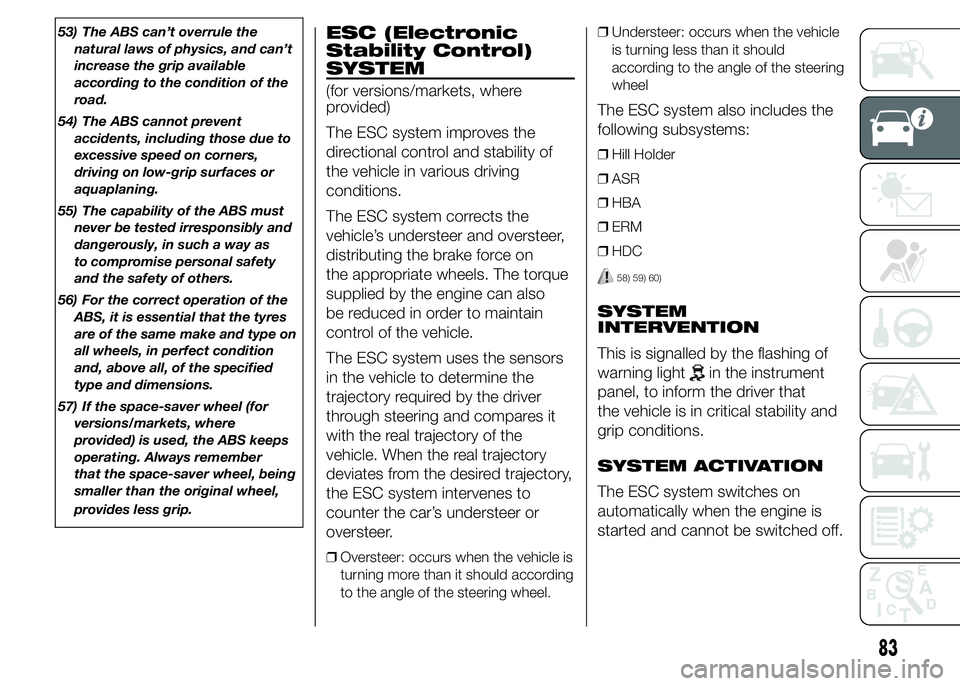
53) The ABS can’t overrule the
natural laws of physics, and can’t
increase the grip available
according to the condition of the
road.
54) The ABS cannot prevent
accidents, including those due to
excessive speed on corners,
driving on low-grip surfaces or
aquaplaning.
55) The capability of the ABS must
never be tested irresponsibly and
dangerously, in such a way as
to compromise personal safety
and the safety of others.
56) For the correct operation of the
ABS, it is essential that the tyres
are of the same make and type on
all wheels, in perfect condition
and, above all, of the specified
type and dimensions.
57) If the space-saver wheel (for
versions/markets, where
provided) is used, the ABS keeps
operating. Always remember
that the space-saver wheel, being
smaller than the original wheel,
provides less grip.ESC (Electronic
Stability Control)
SYSTEM
(for versions/markets, where
provided)
The ESC system improves the
directional control and stability of
the vehicle in various driving
conditions.
The ESC system corrects the
vehicle’s understeer and oversteer,
distributing the brake force on
the appropriate wheels. The torque
supplied by the engine can also
be reduced in order to maintain
control of the vehicle.
The ESC system uses the sensors
in the vehicle to determine the
trajectory required by the driver
through steering and compares it
with the real trajectory of the
vehicle. When the real trajectory
deviates from the desired trajectory,
the ESC system intervenes to
counter the car’s understeer or
oversteer.
❒Oversteer: occurs when the vehicle is
turning more than it should according
to the angle of the steering wheel.❒Understeer: occurs when the vehicle
is turning less than it should
according to the angle of the steering
wheel
The ESC system also includes the
following subsystems:
❒Hill Holder
❒ASR
❒HBA
❒ERM
❒HDC
58) 59) 60)
SYSTEM
INTERVENTION
This is signalled by the flashing of
warning light
in the instrument
panel, to inform the driver that
the vehicle is in critical stability and
grip conditions.
SYSTEM ACTIVATION
The ESC system switches on
automatically when the engine is
started and cannot be switched off.
83
Page 88 of 367
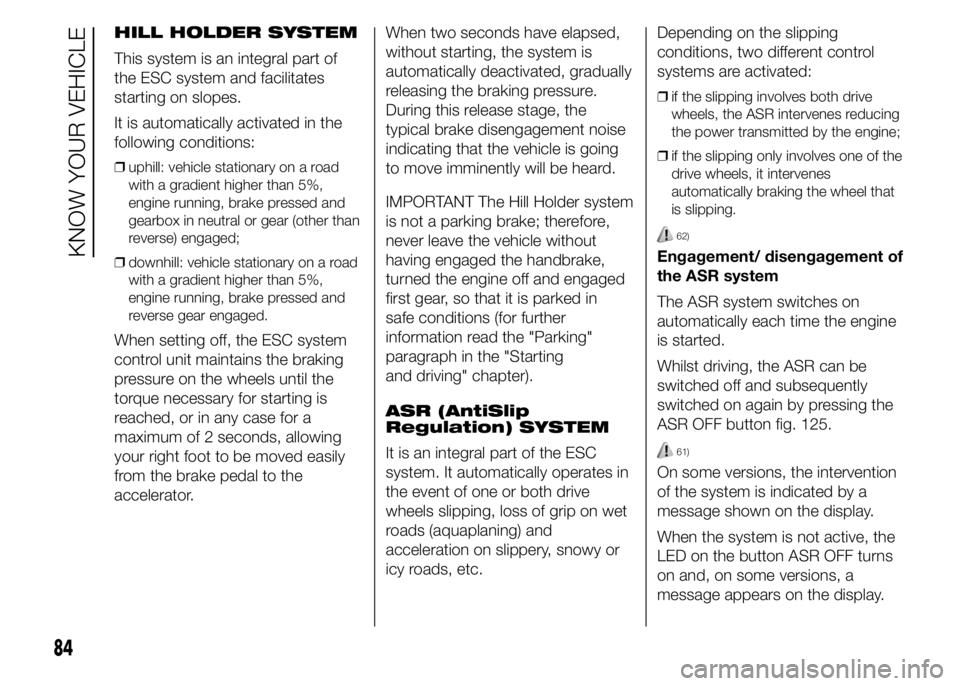
HILL HOLDER SYSTEM
This system is an integral part of
the ESC system and facilitates
starting on slopes.
It is automatically activated in the
following conditions:
❒uphill: vehicle stationary on a road
with a gradient higher than 5%,
engine running, brake pressed and
gearbox in neutral or gear (other than
reverse) engaged;
❒downhill: vehicle stationary on a road
with a gradient higher than 5%,
engine running, brake pressed and
reverse gear engaged.
When setting off, the ESC system
control unit maintains the braking
pressure on the wheels until the
torque necessary for starting is
reached, or in any case for a
maximum of 2 seconds, allowing
your right foot to be moved easily
from the brake pedal to the
accelerator.When two seconds have elapsed,
without starting, the system is
automatically deactivated, gradually
releasing the braking pressure.
During this release stage, the
typical brake disengagement noise
indicating that the vehicle is going
to move imminently will be heard.
IMPORTANT The Hill Holder system
is not a parking brake; therefore,
never leave the vehicle without
having engaged the handbrake,
turned the engine off and engaged
first gear, so that it is parked in
safe conditions (for further
information read the "Parking"
paragraph in the "Starting
and driving" chapter).
ASR (AntiSlip
Regulation) SYSTEM
It is an integral part of the ESC
system. It automatically operates in
the event of one or both drive
wheels slipping, loss of grip on wet
roads (aquaplaning) and
acceleration on slippery, snowy or
icy roads, etc.Depending on the slipping
conditions, two different control
systems are activated:
❒if the slipping involves both drive
wheels, the ASR intervenes reducing
the power transmitted by the engine;
❒if the slipping only involves one of the
drive wheels, it intervenes
automatically braking the wheel that
is slipping.
62)
Engagement/ disengagement of
the ASR system
The ASR system switches on
automatically each time the engine
is started.
Whilst driving, the ASR can be
switched off and subsequently
switched on again by pressing the
ASR OFF button fig. 125.
61)
On some versions, the intervention
of the system is indicated by a
message shown on the display.
When the system is not active, the
LED on the button ASR OFF turns
on and, on some versions, a
message appears on the display.
84
KNOW YOUR VEHICLE
Page 89 of 367
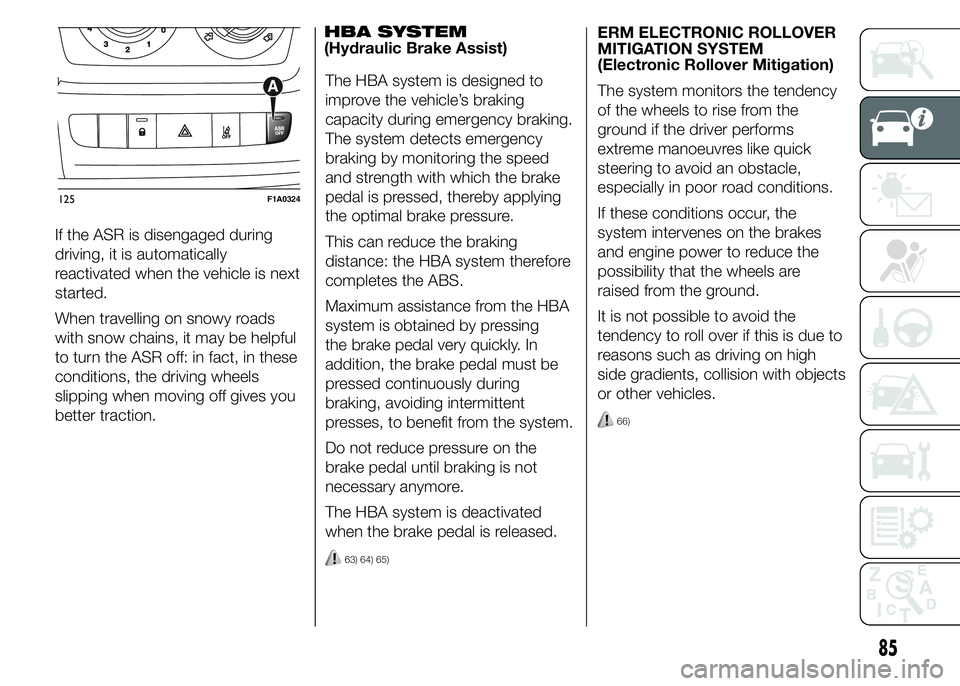
If the ASR is disengaged during
driving, it is automatically
reactivated when the vehicle is next
started.
When travelling on snowy roads
with snow chains, it may be helpful
to turn the ASR off: in fact, in these
conditions, the driving wheels
slipping when moving off gives you
better traction.HBA SYSTEM
(Hydraulic Brake Assist)
The HBA system is designed to
improve the vehicle’s braking
capacity during emergency braking.
The system detects emergency
braking by monitoring the speed
and strength with which the brake
pedal is pressed, thereby applying
the optimal brake pressure.
This can reduce the braking
distance: the HBA system therefore
completes the ABS.
Maximum assistance from the HBA
system is obtained by pressing
the brake pedal very quickly. In
addition, the brake pedal must be
pressed continuously during
braking, avoiding intermittent
presses, to benefit from the system.
Do not reduce pressure on the
brake pedal until braking is not
necessary anymore.
The HBA system is deactivated
when the brake pedal is released.
63) 64) 65)
ERM ELECTRONIC ROLLOVER
MITIGATION SYSTEM
(Electronic Rollover Mitigation)
The system monitors the tendency
of the wheels to rise from the
ground if the driver performs
extreme manoeuvres like quick
steering to avoid an obstacle,
especially in poor road conditions.
If these conditions occur, the
system intervenes on the brakes
and engine power to reduce the
possibility that the wheels are
raised from the ground.
It is not possible to avoid the
tendency to roll over if this is due to
reasons such as driving on high
side gradients, collision with objects
or other vehicles.
66)
125F1A0324
85
Page 92 of 367
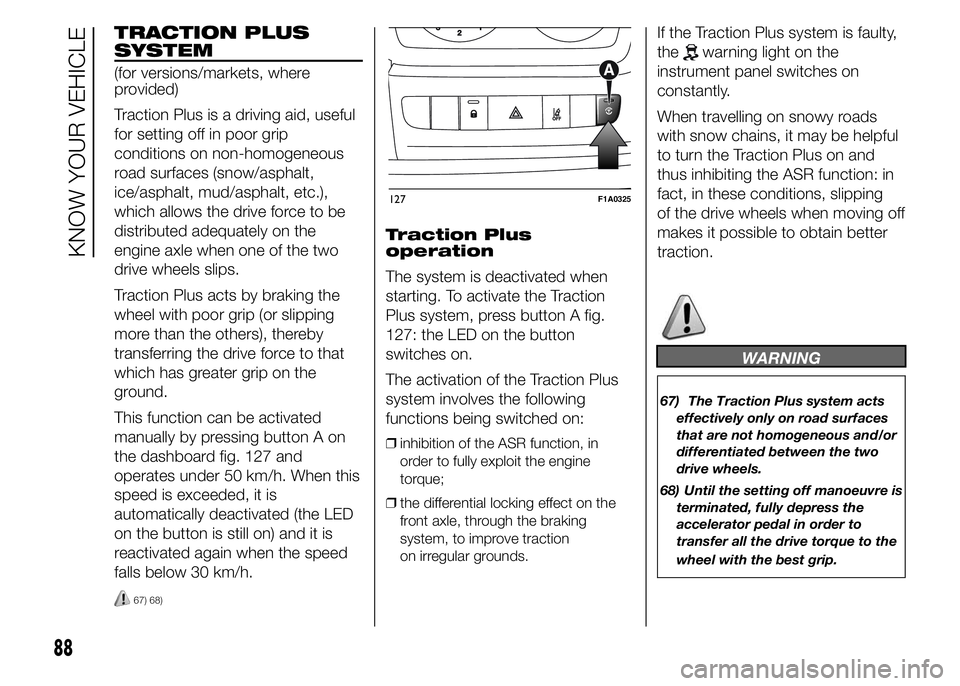
TRACTION PLUS
SYSTEM
(for versions/markets, where
provided)
Traction Plus is a driving aid, useful
for setting off in poor grip
conditions on non-homogeneous
road surfaces (snow/asphalt,
ice/asphalt, mud/asphalt, etc.),
which allows the drive force to be
distributed adequately on the
engine axle when one of the two
drive wheels slips.
Traction Plus acts by braking the
wheel with poor grip (or slipping
more than the others), thereby
transferring the drive force to that
which has greater grip on the
ground.
This function can be activated
manually by pressing button A on
the dashboard fig. 127 and
operates under 50 km/h. When this
speed is exceeded, it is
automatically deactivated (the LED
on the button is still on) and it is
reactivated again when the speed
falls below 30 km/h.
67) 68)
Traction Plus
operation
The system is deactivated when
starting. To activate the Traction
Plus system, press button A fig.
127: the LED on the button
switches on.
The activation of the Traction Plus
system involves the following
functions being switched on:
❒inhibition of the ASR function, in
order to fully exploit the engine
torque;
❒the differential locking effect on the
front axle, through the braking
system, to improve traction
on irregular grounds.
If the Traction Plus system is faulty,
the
warning light on the
instrument panel switches on
constantly.
When travelling on snowy roads
with snow chains, it may be helpful
to turn the Traction Plus on and
thus inhibiting the ASR function: in
fact, in these conditions, slipping
of the drive wheels when moving off
makes it possible to obtain better
traction.
WARNING
67) The Traction Plus system acts
effectively only on road surfaces
that are not homogeneous and/or
differentiated between the two
drive wheels.
68) Until the setting off manoeuvre is
terminated, fully depress the
accelerator pedal in order to
transfer all the drive torque to the
wheel with the best grip.
127F1A0325
88
KNOW YOUR VEHICLE